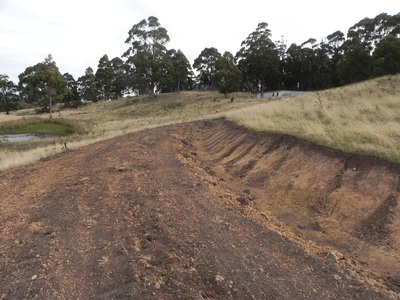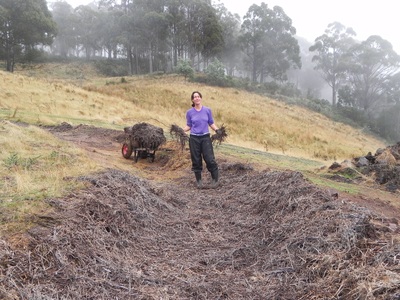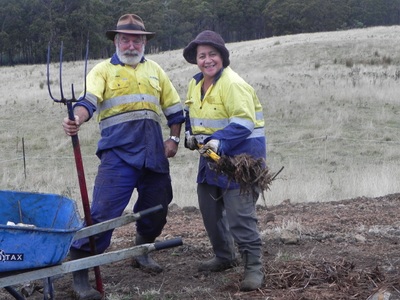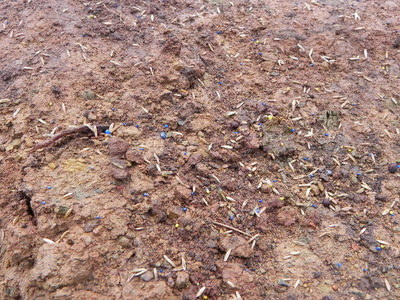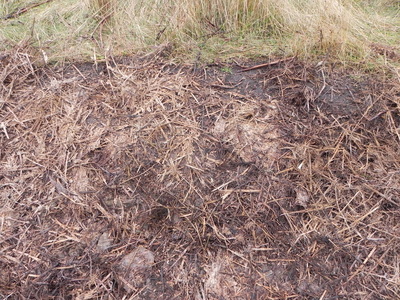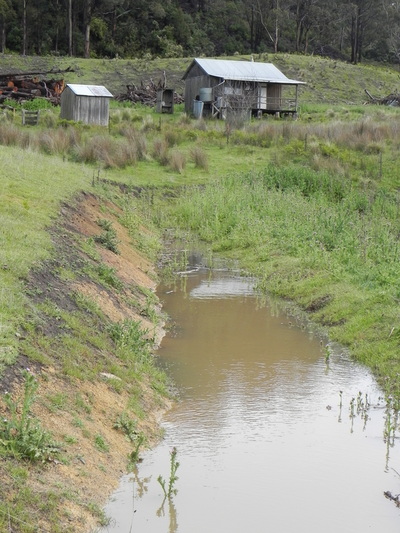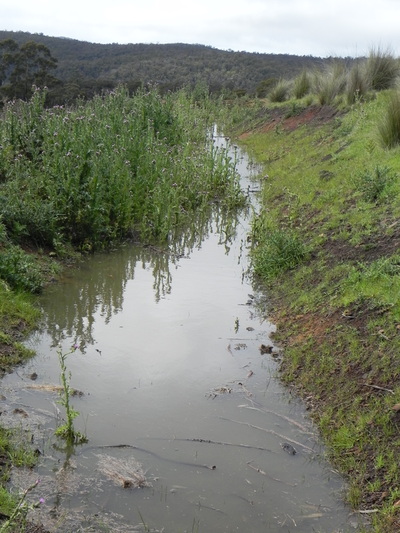2012 - Water Harvesting Earthworks
Tiger Hill Permaculture Phase 1 Water Harvesting Earthworks
In February 2011 I took over the farm Tiger Hill. The planets aligned at that time in my life as I had a deep desire to find a property that I could develop to get all of my experience and ideas toward Permaculture on the ground and create my long term vision of an educational community and demonstration site based on Permaculture Design.
I purposely searched for a property that had reasonable rainfall but on the low side of average so my water harvesting strategies could be showcased. The annual rainfall in this area is 300mm – 600mm depending on who you talk to. This was adequate and any less could really be a struggle to a project starting off with nothing in the way of resources. At the time I lived in WA and land prices were way too high to have to commit to a 30 year mortgage.
When I first walked onto this property, it felt like I was returning home and the feeling of being connected to the land filled all of my senses. The property had all the things on my list of needful which included;
Being an earthworks guy and having spent all of my life around heavy machinery, I found that my path in Permaculture was one of reshaping the land for good. My job has been in civil and mining sectors and I have dug the earth for all imagined purposes but none too really fulfilling. I now see that my way is to use my special skill set to help the earth heal. After the first year of observation of seasonal conditions I was itching to start digging the ground. I follow my gut a lot and it told me the time was right after all of the consideration I had played thru. Good, Bad, Indifferent. I had topo and aerial photos of the site and went about designing the water harvesting strategies based on my limited knowledge of Keyline principles and overlayed roads, dam sites, fencing and forestry onto the map. I had some experience with Keyline when I worked in Vietnam alongside Darren Doherty and on the forestry project, Dalpura Farm in Victoria
Three things to consider on any site are Water, Access and Structures. I had two of the three in water and structures and had to work on the access to get across the site to avoid compaction and increase water harvesting capabilities. The existing water infrastructure needs some tweaking but most of the system is there, it just needs to be connected holistically. The structures on site are fantastic and all buildings are to be repurposed for classroom, bunkhouse and future manager’s quarters as well as other temporary accommodations
The local area geology is predominantly sand stone with a topsoil depth of between 150mm – 250mm with and alluvial sandstone soil with dispersible clays. As I was not familiar to this type of soil, I consulted the local resource management group and found out the soil is considered to be of a sodic type. Sodic soils are soils that vary depending on various chemicals present. Sodic soils are characterized by a disproportionately high concentration of sodium (Na) in their cation exchange complex. They are usually defined as consisting an exchangeable sodium percentage greater than 15%. These soils tend to occur within arid to semiarid regions and are innately unstable, exhibiting poor physical and chemical properties, which impede water infiltration, water availability, and ultimately plant growth. After taking a test sample it was determined the pH was 7. I was told that at pH 7 the soil is a workable and gypsum will help reduce the dispersion and if a ground cover is promoted straight away it lessens the effect of possible tunnel erosion down slope. The future plan on site is to have a soil building program using a Yeomans Plough and direct sow into rip lines. Gypsum may be applied to help any dispersion. Initially, the ripping will start shallow and as soil build, the ripping will increase in depth. This is hoped to improve water infiltration as well as pasture health for stock grazing.
Once I spent some more time looking over my base plan I continued to observe and fine tune the plan and then on Easter 2012 I dove in and dry hired a 5 ton excavator from Coates Hire for the long weekend and worked that machine around the clock for the 3 days to implement phase 1 of my water harvesting plan. The 5 ton machine cost $350.00 per day, but hired over a long weekend got 3 days for the price of 2. Transport was in the form of a flatbed tilt tray. I had to consider the size of machine when doing this, for one reason was the job size and second the transport costs. Anything over 12 ton weight requires a bigger truck and float (in Tas anyway) to carry and thus costs more.
Keeping in mind the forestry layout, I started surveying the ground with my LL100 Spectrum Precision Laser Level. This is a magic piece of kit and it has travelled with me thru India and Afghanistan on aid projects. I had to do and redo this several times to finalize the swale start and finish points to maintain the bigger long term plan. An existing dam at the proposed exit point of the swale is to be extended in the future to have the wall height raised 4 meters, so the overflow from the swale needed to be in an appropriate position in the landscape for this to be fully effective.
Initially the start point level indicated that the swale would go across a steeper area, so I resurveyed to have the final contour line avoid this so I could access the area in future with a tractor as well as suit the exit point level. All this surveying takes time but it is time well spent before any digging commences. I then set the machine up so it was parallel to the slope and in a way that I had the survey marks (wooden stakes) on the uphill excavator track alignment and so I could reach at full extension with the machine bucket onto the slope. By being in this position and not running over the survey markers, the distance remains the same all the way along the contour. Survey markers were placed every 3-4 meters so a good line could be followed.
In a traditional swale, the excavated earth is mounded and uncompacted, but in my design I have levelled out the mound so as to suit the landscape as well as to not lose valuable grass areas for the cows. The swale was dug to a depth of approx. 400mm and the laser was set up to check levels as I went. As I have considerable experience on this type of machine, I found that positioning the bucket against the uncut wall served as a depth gauge and reduce the time out of the machine. I normally am pretty good with digging levels without level checks. This comes with years of experience and acknowledging a way that the body senses being uneven in the seat of the equipment. Sort of like an internal gyroscope. Having a good depth of field is also important for identifying positions in the landscape on contour at a distance. This skill has come from operating up to 700 ton excavators with a seating position 3 storeys above the ground and the need to maintain a level floor grade.
Once water fills in the swale it overflows out a level sill spill way over an undisturbed grassed slope. The level sill spill way is wide enough the water spreads over the full width of the spill way very passively to avoid erosion. If spill ways are too narrow, water will gain speed and pressure over the area and increase the possibility of erosion during times of surge caused by intense rainfall periods.
I excavated the entire swale over the 3 days just in time for the transport to pick the machine up again. The final length was approx. 300 meters. The machine used about 20 litres of fuel a day which is pretty good considering how hard I worked it. The good thing about the dry hire arrangement is that the long term maintenance is not an issue to the hirer. Being reasonably new equipment as well ensures it is reliable. Nothing worse than having an intensive work plan, and then the machine breaks down.
A good rule of thumb when hiring equipment is to consider the condition it is in. If you are hiring a contractor and the machine looks rough, then it is probably an indication of his work also. A contractor who has pride in his machine also has pride in his work.
Once I completed the excavation, the exposed earthen embankment need to be seeded and mulched. I had made enquiries at a local sheep farm to see if they sold bales of straw/silage. In the area, fields are slashed and baled for storage just as the grasses turn at the beginning of summer. The farmer had some old silage that had sweated within the covering and made them unpalatable for the stock. He offered me these 400kg bales for $5 each and I purchased 15 of them. My little farm truck has been a real saviour when it comes to transporting resources. I can fit 3 of these bales onto the truck at a time and then tip them where ever they are needed on site. Just as I was planning to start covering the swale with the silage, I was contacted by a volunteer who want to come and help on the farm. This was the first volunteer on site and Hilary and her parents, George and Lorna and I fully mulched and seed the 300 meter excavation in 3 days.
I returned home from working in Zambia, Africa in November 2013 and the day after I returned an intense rain shower passed thru the property. While I was inspecting the effects of the storm I was surprised to find that the swale had filled and about to overflow. It had been raining prior to my return as I noticed the rain gauge had about 100ml in it which has accumulated in my 2 month absence. I was elated with this as the entire swale was holding water and it did so for 3 days after. I raced back to the house, grabbed the camera and filmed the event and took stills. It confirmed my digging levels as well as my level sill spill way levels.
Phase 2 of the water harvesting program is expected to commence in February 2015 and Tiger Hill Permaculture will be hosting a Specialised Earthworks Practicum and Work Experience Program as well as an Introductory Earthworks Course leading into the full practicum. This course will follow a 2 week intensive residential Permaculture Design Course scheduled to start on 2nd February 2015.
The attached photos are the documented process from start to finish over 1½ years.
In February 2011 I took over the farm Tiger Hill. The planets aligned at that time in my life as I had a deep desire to find a property that I could develop to get all of my experience and ideas toward Permaculture on the ground and create my long term vision of an educational community and demonstration site based on Permaculture Design.
I purposely searched for a property that had reasonable rainfall but on the low side of average so my water harvesting strategies could be showcased. The annual rainfall in this area is 300mm – 600mm depending on who you talk to. This was adequate and any less could really be a struggle to a project starting off with nothing in the way of resources. At the time I lived in WA and land prices were way too high to have to commit to a 30 year mortgage.
When I first walked onto this property, it felt like I was returning home and the feeling of being connected to the land filled all of my senses. The property had all the things on my list of needful which included;
- A house
- Out buildings
- Water
- Pasture
- Forest
- A maximum 1 hour from Hobart airport.
- Fencing
- Reasonable access
- Reasonable price
- 3 bedroom, 12 year old house built from timber on site
- 9 sheds including 2 cabins and a shearing shed
- 9 dams of various size and water holding capability
- Approx 50 acres of pasture
- Approx 20 acres of forest
- 45 minutes from Hobart airport and 1 hour from Hobart
- Fully fenced including electric
- Good access at the end of a no thru road. Nearest neighbour 10km away.
- Under budget
Being an earthworks guy and having spent all of my life around heavy machinery, I found that my path in Permaculture was one of reshaping the land for good. My job has been in civil and mining sectors and I have dug the earth for all imagined purposes but none too really fulfilling. I now see that my way is to use my special skill set to help the earth heal. After the first year of observation of seasonal conditions I was itching to start digging the ground. I follow my gut a lot and it told me the time was right after all of the consideration I had played thru. Good, Bad, Indifferent. I had topo and aerial photos of the site and went about designing the water harvesting strategies based on my limited knowledge of Keyline principles and overlayed roads, dam sites, fencing and forestry onto the map. I had some experience with Keyline when I worked in Vietnam alongside Darren Doherty and on the forestry project, Dalpura Farm in Victoria
Three things to consider on any site are Water, Access and Structures. I had two of the three in water and structures and had to work on the access to get across the site to avoid compaction and increase water harvesting capabilities. The existing water infrastructure needs some tweaking but most of the system is there, it just needs to be connected holistically. The structures on site are fantastic and all buildings are to be repurposed for classroom, bunkhouse and future manager’s quarters as well as other temporary accommodations
The local area geology is predominantly sand stone with a topsoil depth of between 150mm – 250mm with and alluvial sandstone soil with dispersible clays. As I was not familiar to this type of soil, I consulted the local resource management group and found out the soil is considered to be of a sodic type. Sodic soils are soils that vary depending on various chemicals present. Sodic soils are characterized by a disproportionately high concentration of sodium (Na) in their cation exchange complex. They are usually defined as consisting an exchangeable sodium percentage greater than 15%. These soils tend to occur within arid to semiarid regions and are innately unstable, exhibiting poor physical and chemical properties, which impede water infiltration, water availability, and ultimately plant growth. After taking a test sample it was determined the pH was 7. I was told that at pH 7 the soil is a workable and gypsum will help reduce the dispersion and if a ground cover is promoted straight away it lessens the effect of possible tunnel erosion down slope. The future plan on site is to have a soil building program using a Yeomans Plough and direct sow into rip lines. Gypsum may be applied to help any dispersion. Initially, the ripping will start shallow and as soil build, the ripping will increase in depth. This is hoped to improve water infiltration as well as pasture health for stock grazing.
Once I spent some more time looking over my base plan I continued to observe and fine tune the plan and then on Easter 2012 I dove in and dry hired a 5 ton excavator from Coates Hire for the long weekend and worked that machine around the clock for the 3 days to implement phase 1 of my water harvesting plan. The 5 ton machine cost $350.00 per day, but hired over a long weekend got 3 days for the price of 2. Transport was in the form of a flatbed tilt tray. I had to consider the size of machine when doing this, for one reason was the job size and second the transport costs. Anything over 12 ton weight requires a bigger truck and float (in Tas anyway) to carry and thus costs more.
Keeping in mind the forestry layout, I started surveying the ground with my LL100 Spectrum Precision Laser Level. This is a magic piece of kit and it has travelled with me thru India and Afghanistan on aid projects. I had to do and redo this several times to finalize the swale start and finish points to maintain the bigger long term plan. An existing dam at the proposed exit point of the swale is to be extended in the future to have the wall height raised 4 meters, so the overflow from the swale needed to be in an appropriate position in the landscape for this to be fully effective.
Initially the start point level indicated that the swale would go across a steeper area, so I resurveyed to have the final contour line avoid this so I could access the area in future with a tractor as well as suit the exit point level. All this surveying takes time but it is time well spent before any digging commences. I then set the machine up so it was parallel to the slope and in a way that I had the survey marks (wooden stakes) on the uphill excavator track alignment and so I could reach at full extension with the machine bucket onto the slope. By being in this position and not running over the survey markers, the distance remains the same all the way along the contour. Survey markers were placed every 3-4 meters so a good line could be followed.
In a traditional swale, the excavated earth is mounded and uncompacted, but in my design I have levelled out the mound so as to suit the landscape as well as to not lose valuable grass areas for the cows. The swale was dug to a depth of approx. 400mm and the laser was set up to check levels as I went. As I have considerable experience on this type of machine, I found that positioning the bucket against the uncut wall served as a depth gauge and reduce the time out of the machine. I normally am pretty good with digging levels without level checks. This comes with years of experience and acknowledging a way that the body senses being uneven in the seat of the equipment. Sort of like an internal gyroscope. Having a good depth of field is also important for identifying positions in the landscape on contour at a distance. This skill has come from operating up to 700 ton excavators with a seating position 3 storeys above the ground and the need to maintain a level floor grade.
Once water fills in the swale it overflows out a level sill spill way over an undisturbed grassed slope. The level sill spill way is wide enough the water spreads over the full width of the spill way very passively to avoid erosion. If spill ways are too narrow, water will gain speed and pressure over the area and increase the possibility of erosion during times of surge caused by intense rainfall periods.
I excavated the entire swale over the 3 days just in time for the transport to pick the machine up again. The final length was approx. 300 meters. The machine used about 20 litres of fuel a day which is pretty good considering how hard I worked it. The good thing about the dry hire arrangement is that the long term maintenance is not an issue to the hirer. Being reasonably new equipment as well ensures it is reliable. Nothing worse than having an intensive work plan, and then the machine breaks down.
A good rule of thumb when hiring equipment is to consider the condition it is in. If you are hiring a contractor and the machine looks rough, then it is probably an indication of his work also. A contractor who has pride in his machine also has pride in his work.
Once I completed the excavation, the exposed earthen embankment need to be seeded and mulched. I had made enquiries at a local sheep farm to see if they sold bales of straw/silage. In the area, fields are slashed and baled for storage just as the grasses turn at the beginning of summer. The farmer had some old silage that had sweated within the covering and made them unpalatable for the stock. He offered me these 400kg bales for $5 each and I purchased 15 of them. My little farm truck has been a real saviour when it comes to transporting resources. I can fit 3 of these bales onto the truck at a time and then tip them where ever they are needed on site. Just as I was planning to start covering the swale with the silage, I was contacted by a volunteer who want to come and help on the farm. This was the first volunteer on site and Hilary and her parents, George and Lorna and I fully mulched and seed the 300 meter excavation in 3 days.
I returned home from working in Zambia, Africa in November 2013 and the day after I returned an intense rain shower passed thru the property. While I was inspecting the effects of the storm I was surprised to find that the swale had filled and about to overflow. It had been raining prior to my return as I noticed the rain gauge had about 100ml in it which has accumulated in my 2 month absence. I was elated with this as the entire swale was holding water and it did so for 3 days after. I raced back to the house, grabbed the camera and filmed the event and took stills. It confirmed my digging levels as well as my level sill spill way levels.
Phase 2 of the water harvesting program is expected to commence in February 2015 and Tiger Hill Permaculture will be hosting a Specialised Earthworks Practicum and Work Experience Program as well as an Introductory Earthworks Course leading into the full practicum. This course will follow a 2 week intensive residential Permaculture Design Course scheduled to start on 2nd February 2015.
The attached photos are the documented process from start to finish over 1½ years.



